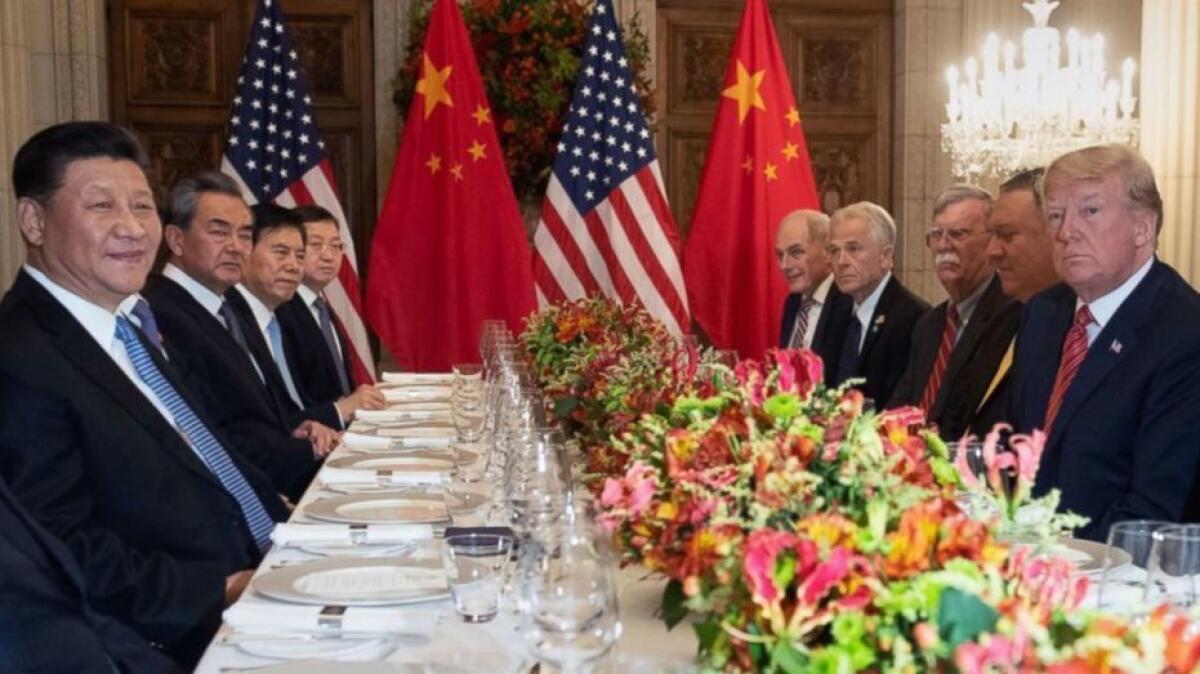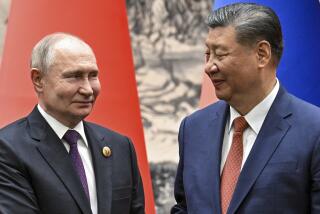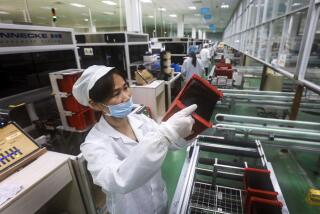Trump and Chinese President Xi Jinping agree to a cease-fire on trade

Reporting from Buenos Aires — President Trump and his Chinese counterpart, Xi Jinping, agreed to a cease-fire on trade after meeting for more than two hours Saturday after the close of the Group of 20 summit in the Argentine capital.
Under the agreement, Trump won’t raise tariffs while negotiations continue and China will purchase more U.S. agricultural and energy products, the White House said in a statement issued three hours after the meeting ended.
“This was an amazing and productive meeting with unlimited possibilities for both the United States and China,” Trump said in a statement that marked a major de-escalation of rhetoric toward China. “It is my great honor to be working with President Xi.”
The tenuous truce between the two leaders means that Trump is essentially backing off his threat to raise U.S. tariffs on $200 billion worth of goods from 10% to 25% on Jan. 1 — for now.
“President Trump and President Xi have agreed to immediately begin negotiations on structural changes with respect to forced technology transfer, intellectual property protection, non-tariff barriers, cyber intrusions and cyber theft, services and agriculture,” said the statement from Press Secretary Sarah Huckabee Sanders. “Both parties agree that they will endeavor to have this transaction completed within the next 90 days. If at the end of this period of time, the parties are unable to reach an agreement, the 10% tariffs will be raised to 25%.”
“The proof of tonight’s pudding will be in the eating,” said David Loevinger, a managing director at TCW Emerging Markets Group in Los Angeles and a former senior Treasury Department official for China affairs. “There was clearly a lot more that wasn’t agreed than was. Neither side is tying their hands.”
Trump and Xi met over a working dinner in Buenos Aires, where world leaders had convened against the backdrop of slowing global growth and mounting tensions on trade — none more consequential than the conflict between the United States and China.
It was the first face-to-face meeting for the two leaders in more than a year and the first since Trump launched the opening round of punitive tit-for-tat tariffs that have roiled financial markets and intensified worries of an emerging cold war with far-reaching repercussions.
A cease-fire will be welcomed by businesses, consumer groups and others as it would avert, for now, Trump’s previously announced move to boost tariffs on $200 billion of Chinese goods next month to 25% from the initially imposed tax of 10%. Many of these items are ordinary household products like vacuum cleaners.
The talks came a day after Trump and his Mexican and Canadian counterparts signed a revised North American Free Trade Agreement after 13 months of often acrimonious negotiations. Trump hailed the deal as a major success for his administration, but it faces skepticism in Congress, which must approve it before it can take effect.
Ahead of the dinner, analysts were projecting one of three possible outcomes: a grand bargain with substantive action steps; a superficial deal without clear commitments; or essentially the status quo.
While details were sketchy, the result looked to be somewhere between the first and second.
Xi was expected to offer to reopen China’s market to American soybeans and other farm goods, as well as a commitment to address long-standing U.S. concerns that China is stealing U.S. intellectual property and that its policies discriminate against foreign companies and essentially coerce them to hand over technologies to gain access to Chinese markets.
Some of Trump’s top advisors, including U.S. Trade Representative Robert Lighthizer, have sought to ratchet up pressure on Beijing, skeptical of its sincerity to make fundamental structural changes in its economic behavior. Under Xi, China has moved to enhance the role of the Communist Party and state-owned firms with a campaign to build up dominance in critical technologies and sectors.
Several days ago, Trump said he was “highly unlikely” to hold off raising tariffs scheduled for Jan. 1. But he also has spoken with some relish of making a deal, in no small part because doing so and pulling back from the brink of a full-out trade war would likely bolster stocks and could help sustain America’s long economic expansion as he looks ahead to the 2020 election.
Trump also has persistently noted his personal chemistry with Xi, from whom Trump needs help for his foreign policy goal and personal ambition to ease North Korea’s nuclear threat.
At the start of a dinner that featured sirloin steak and caramel rolled pancakes, Trump and Xi exchanged warm greetings. The Chinese leader said he was “very saddened” by the death of former President George H.W. Bush and that it was a “great pleasure” to meet with Trump, citing their “personal friendship.”
Trump described their relationship as “very special,” adding, “I think that is going to be a primary reason why we’ll probably end up getting something that will be good for China and good for the United States.” Sitting to Trump’s right was Secretary of State Michael R. Pompeo and to his left Treasury Secretary Steven T. Mnuchin.
Because of Trump’s unpredictability and the uncertainty of how much ground Xi was willing to give, their so-called working dinner was marked with suspense. It largely overshadowed the two-day proceedings of the G-20 summit, ostensibly the global forum for international economic cooperation.
The leaders representing 85% of the world economy were marking the 10th anniversary of the G-20, but the summit was fraught with uncertainties over trade and the future path of multilateralism, particularly with the U.S. and China, the two biggest economies, seeming to barrel ahead like two oncoming trains.
The U.S.-China discord hung over the recent Asia-Pacific Economic Cooperation summit, during which the 21 members could not agree on a joint statement for the first time ever.
At the conclusion of G-20, the parties issued a declaration but papered over major differences. The eight-page statement made only passing reference to trade tensions and no mention of the rising trend of protectionism and how it might hurt growth.
U.S. officials, however, claimed success in that the communique noted the need for improving the World Trade Organization, the arbiter of international trade disputes that the Trump administration has criticized as ineffective in dealing with China’s large-scale actions.
With the G-20 agreeing on reforming the WTO, the U.S. and China could find more reason to allow international rules to resolve bilateral trade spats, instead of “weaponizing” trade, said Wallace S. Cheng, a trade expert based in Geneva.
As in last year’s G-20 joint statement, the latest one noted Trump’s decision to withdraw the United States from the Paris accord on climate change. “But what was interesting,” noted a senior U.S. official in Buenos Aires, “is that this was one of the last issues to close because the countries who typically might agree couldn’t agree with each other.” The official said that “you’re seeing a little bit of the coalition fraying. Countries like Turkey, like Saudi Arabia, like Russia might be second-guessing some of that.”
Ahead of his dinner with Xi, Trump gave mixed signals about what could be expected. He called it a “very important” meeting, but then, referring to the death of George H.W. Bush on Saturday, said that the loss of the 41st president “really puts a damper on it.”
Yet it appeared that aides representing both Trump and Xi had been quietly negotiating over long-distance in recent weeks to craft a deal that could allow the leaders to step back from the brink of a full-blown trade war. But both sides kept things under wraps over the last two days, with the Chinese side canceling most of its scheduled news conferences.
Already the United States has slapped tariffs on $250 billion of Chinese goods, or about half of all imported products from China. Beijing has fired back by imposing similar tariffs on about $110 billion of American merchandise, or about 85% of all imports from the United States.
Thus far, China has felt the greater pain from the exchange of tariffs, in part because the Asian country relies more on exports and its economy has been struggling with an overhang in debt and flagging property market.
By comparison, the American economy has been sailing along, but White House economic advisors also are said to have warned Trump of slowing growth as stimulus from the big tax cuts wane and higher interest rates bite.
While the dinner deal offered hope, the hard work remains, with the possibility that either leader, with big personal ambitions and domestic constituents to make happy, could pull the plug on a lasting détente.
Moreover, a freeze or even a future pullback of all tariffs isn’t likely to end tensions between Washington and Beijing as a rising China competes for supremacy with the United States in the Western Pacific, where the Chinese military has taken over and expanded a series of disputed islands and shoals.
Times staff writer Eli Stokols contributed to this report.
Twitter: @dleelatimes
UPDATES:
6:55 p.m.: This article has been updated with Trump and Xi agreeing to a cease-fire on trade war.
This article was originally posted at 10:20 a.m.
More to Read
Get the L.A. Times Politics newsletter
Deeply reported insights into legislation, politics and policy from Sacramento, Washington and beyond. In your inbox three times per week.
You may occasionally receive promotional content from the Los Angeles Times.











